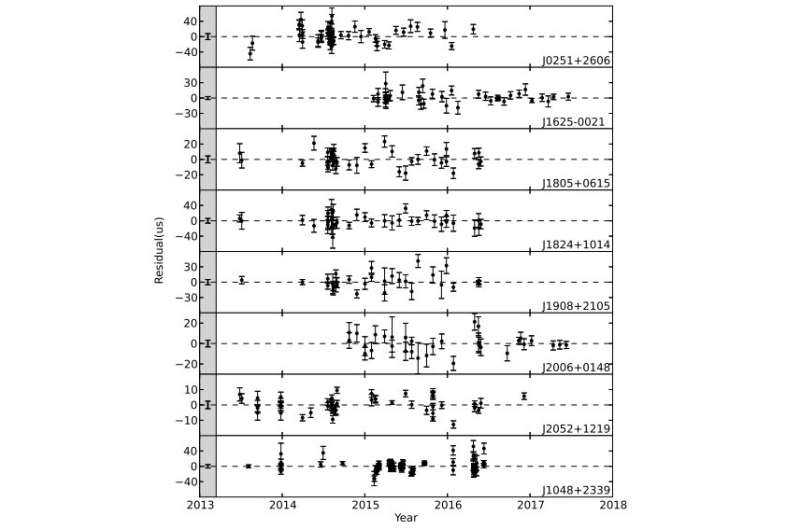January 11, 2021 report
Eight binary millisecond pulsars examined by researchers

Using the Arecibo 305-m radio telescope, an international team of astronomers has investigated eight binary millisecond pulsars (MSPs). Results of this study, presented in a paper published December 30 on the arXiv pre-print server, provide important information about the properties of these sources.
The most rapidly rotating pulsars, those with rotation periods below 30 milliseconds, are known as millisecond pulsars. It is assumed that they are formed in binary systems when the initially more massive component turns into a neutron star that is then spun-up due to accretion of matter from the secondary star.
A class of extreme binary pulsars with semi-degenerate companion stars is dubbed "spider pulsars." These objects are further categorized as "black widows" if the companion has extremely low mass (less than 0.1 solar masses), while if the secondary star is heavier they are called "redbacks."
Recently, a team of researchers led by Julia Deneva of the George Mason University in Fairfax, Virginia, has conducted radio observations of eight MSPs in order to shed more light into their nature. For their study, they employed the 327 MHz receiver at the Arecibo telescope.
"We present timing solutions for eight binary millisecond pulsars (MSPs) discovered by searching unidentified Fermi-LAT source positions with the 327 MHz receiver of the Arecibo 305-m radio telescope," the astronomers wrote in the paper.
In result, they found that five investigated MSPs, designated J0251+2606, J1805+0615, J1908+2105, J2052+1219 and J1048+2339, can be classified as spider pulsars with short orbital periods (less than 8.1 hours). The remaining three, known as J1625−0021, J1824+1014 and J2006+0148, have white dwarf companions and longer orbital periods.
According to the paper, J0251+2606, J1805+0615 and J2052+1219 are black widows having degenerate companions with masses of around 0.02−0.03 solar masses. They exhibit radio eclipses lasting less than 40% of their orbital periods.
J1048+2339 was found to be a redback hosting a non-degenerate companion with a mass over 0.3 solar masses. The radio emission of the redback is eclipsed about half the time of orbital period, what is typical for this class of spider pulsars.
When it comes to J1908+2105, it exhibits heavy radio eclipses reminiscent of redbacks but has a minimum companion mass of about 0.055 solar masses, which would be either unusually high for a black widow or unusually low for a redback.
"This system may represent a rare middle-ground case between these two observational classes," the astronomers wrote.
Summing up the results, the researchers noted that the likelihood of new MSP discoveries may be improved in future studies by making observations longer than five to 10 minutes and processing them using jerk search codes or in chunks of that duration.
More information: Timing of Eight Binary Millisecond Pulsars Found with Arecibo in Fermi-LAT Unidentified Sources, arXiv:2012.15185 [astro-ph.HE] arxiv.org/abs/2012.15185
© 2021 Science X Network




















